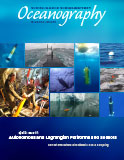First Paragraph
Purpose of Activity. Ocean glider missions can provide a catalyst for student participation and education in oceanography, as recently demonstrated by the trans-Atlantic Slocum glider expeditions operated from Rutgers University (Glenn et al., 2011). For the present activity, we developed a series of hands-on, computer-based exercises that allow students (and other interested users) to become familiar with the types of data collected by ocean gliders, and to learn how to analyze them using visualization software developed specifically for glider data (GLIDERSCOPE; Figure 1). In addition to demonstrating general techniques for oceanographic data analysis and interpretation, this activity explores key principles of physical and biological oceanography that include water column structure, upwelling and mesoscale eddy dynamics, and the distribution of particulate matter within the water column.

